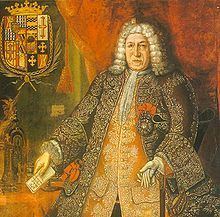Monarch Philip V Religion Catholic Name Jose de | Preceded by Jose de Armendariz Signature | |
 | ||
Role 3rd Marquis of Villagarcia Died December 17, 1746, Cape Horn, Chile Succeeded by Jose Manso de Velasco, 1st Count of Superunda | ||
Jose Antonio de Mendoza Caamano y Sotomayor, 3rd Marquis of Villagarcia de Arousa (sometimes marques de Villa Garcia) (1667, Spain – December 17, 1746, Cape Horn) was a Spanish colonial administrator in the Americas. From February 4, 1736 to December 15, 1745 he was Viceroy of Peru.
Contents
Early career
Jose Antonio de Mendoza was a native of Galicia[1] and a knight of the Order of Santiago. He had been ambassador to Venice and viceroy of Catalonia when King Philip V named him Viceroy of Peru in 1735. He took office in Lima, the capital of the Viceroyalty of Peru the following year, at the age of 68 in 1736.
During his administration, war between Spain and England again broke out, the War of Jenkins' Ear, 1739–1748. Viceroy Mendoza organized the defense of the Pacific coast and improved the army and the militia. In 1742 he dispatched a fleet from the port of El Callao to go to defend the coast of Chile.
Scientists
In 1736 Spanish scientists Jorge Juan y Santacilia and Antonio de Ulloa, sent by the French Academy on a French Geodesic Mission to measure a degree of meridian arc at the equator, arrived in the Viceroyalty colony. Jorge Juan y Santacilia had sailed on the same ship as Viceroy Mendoza. On their return, they reported on the disorganization and corruption in the government and smuggling. The report was posthumously published under the title Noticias Secretas de Americas (Secret News From Americas). Smuggling increased again during this period. The practice was so profitable that merchants were willing to accept the risks
Another French influence on science in the colony was Louis Godin, another member of the meridian expedition. He was appointed cosmografo mayor by Viceroy Mendoza.[2] The duties of cosmografo mayor included publishing almanacs and sailing instructions. Other French scientists in Peru at this time were Charles Marie de La Condamine and Pierre Bouguer.
Later career
Also during his tenure, an Indigenous peoples revolt for freedom occurred at Oruro (1739) and another led by Juan Santos Atahualpa broke out in 1742 in Oxabamba. This latter revolution gained support in all the native tribes, and also among Mestizos and poor Spaniards. The revolutionaries intent was to drive the Spaniards from Peru. They were unable to do so, but neither were the Spaniards able to defeat them.
In 1740 the Viceroyalty of New Granada was separated from the Viceroyalty of Peru. It had been temporarily separated earlier, from 1717 to 1724 . The new viceroyalty included the territories of Bogota, Quito, Panama and Venezuela, and also a few territories more directly connected to Lima — Maynas, Jaen, Tumbes and Guayaquil.
Death
Viceroy Mendoza was relieved of his Peruvian office in 1745. Jose Antonio de Mendoza died on the voyage returning to Castile in 1745.
